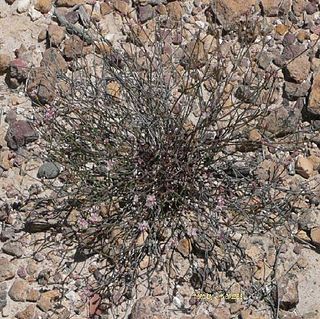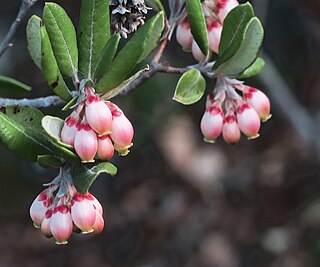
The Santa Cruz cypress is a species of North American tree within the cypress family. The species is endemic to the Santa Cruz Mountains within the Santa Cruz and San Mateo counties of west-central California. The U.S. Fish and Wildlife Service listed the species on the Endangered Species Act in 1987 due to increasing threats from habitat loss and disruption of natural forest fire regimes. In 2016, the conservation status of the Santa Cruz cypress changed to Threatened. The cited reasoning was a decrease in threats against their habitat.

Platanthera yadonii, also known as Yadon's piperia or Yadon's rein orchid, is an endangered orchid endemic to a narrow range of coastal habitat in northern Monterey County, California. In 1998 this plant was designated as an endangered species by the United States government, the major threat to its survival being continuing land development from an expanding human population and associated habitat loss. One of the habitats of Yadon's piperia, the Del Monte Forest near Monterey, California, is the subject of a federal lawsuit, based upon endangerment of this organism along with several other endangered species.

Eriodictyon altissimum is a rare species of flowering plant in the borage family known by the common name Indian Knob mountainbalm. It is endemic to San Luis Obispo County, California, where it is known from only about six occurrences in the Irish Hills on the coast and nearby Indian Knob.

Schenkia sebaeoides, known as ʻĀwiwi in Hawaiian and lavaslope centaury in English, is a rare species of flowering plant. It is endemic to low shrublands in the state of Hawaiʻi in the United States. It is present on the islands of Kauai, Oahu, Lanai, Molokai, and Maui. At the time it was added to the endangered species list of the United States in 1991 it was known from seven populations for a total of fewer than 1000 individuals. It is threatened by habitat loss.

Penstemon haydenii, the blowout penstemon or blowout beardtongue, is a species of flowering plant in the genus Penstemon and the family Plantaginaceae. The warm-season perennial is native to nine counties in the Nebraska Sand Hills and a single location in Carbon County, Wyoming. The plant has a milky blue color with a waxy cuticle, pale purple leaves, and an alternating leaf pattern with one central stalk. The flowers, while in the inflorescence stage, originate from the bases of the leaves of the plant. Blowout penstemon flowers from May until early June and drops its seeds from late August into September.

Arctostaphylos glandulosa, with the common name Eastwood's manzanita, is a species of manzanita.

Eriogonum apricum is a rare species of wild buckwheat known by the common name Ione buckwheat. It is endemic to Amador County, California, in the United States.

Arctostaphylos pallida, commonly known as pallid manzanita, Oakland Hills manzanita, and Alameda manzanita, is an upright manzanita shrub from the Ericaceae, or heath family. It is endemic to the eastern San Francisco Bay Area of Northern California.

Arctostaphylos densiflora, known by the common name Vine Hill manzanita, is a very rare species of manzanita. It is endemic to Sonoma County, California, where it is known from only one extant population of 20 to 30 individual plants. These last wild members of the species are on land near Sebastopol which is owned and protected by the California Native Plant Society. In addition, there are five to ten plants of this manzanita taxon growing on private property about a mile away. The local habitat is mostly chaparral on sandy shale soils.

Arctostaphylos luciana is a species of manzanita known by the common name Santa Lucia manzanita, is endemic to California.

Arctostaphylos montaraensis, known by the common name Montara manzanita, is a species of manzanita in the family Ericaceae.

Arctostaphylos myrtifolia is a rare species of manzanita known by the common name Ione manzanita. It is endemic to the Sierra Nevada foothills of California. It grows in the chaparral and woodland plant community on a distinctive acidic soil series, an oxisol of the Eocene-era Ione Formation, in western Amador and northern Calaveras counties. There are only eleven occurrences, of which three have not been recorded since 1976. This is a federally listed threatened species.

Arctostaphylos obispoensis is a species of manzanita, known by the common names bishop manzanita and serpentine manzanita, endemic to California.

Arctostaphylos pungens, with the common name pointleaf manzanita, is a species of manzanita. It is native to the Southwestern United States and to northern and central Mexico, where it grows in chaparral and woodland habitats, and on desert ridges. Arctostaphylos pungens can be seen growing at Tent Rocks National Monument in New Mexico at an elevation of about 6000 feet.

Arctostaphylos silvicola is a species of manzanita known by the common names Bonny Doon or silverleaf manzanita. It is endemic to the sandhills of the southern Santa Cruz Mountains in California's Santa Cruz and Santa Clara counties.

Camissonia benitensis is a species of evening primrose known by the common names San Benito suncup and San Benito evening primrose. It is endemic to the Diablo Range of the South Coast Ranges of California, where its range includes far southern San Benito County, far western Fresno County, and far eastern Monterey County.

Xylococcus is a monotypic genus of flowering plants in the heather family which contains the single species Xylococcus bicolor, commonly known as the mission manzanita. It is a burl-forming, evergreen shrub with leathery leaves and smooth dark reddish bark. From December to February, white to pink urn-shaped flowers adorn the foliage, often attracting hummingbird pollinators. It is native to southern California and the Baja California Peninsula, south to the Sierra de la Giganta. There is growing concern over the future of this plant, referred to as the "queen of the elfin forest, " as it may possibly lose up to 88% of its habitat and its wild seedlings are failing to survive more than a full year.
The Bonny Doon Ecological Reserve is a nature preserve of 552 acres (2.23 km2) in the Santa Cruz Mountains of California, United States. The reserve protects several rare and endangered plant and animal species within an area known as the Santa Cruz Sandhills, an ancient seabed containing fossilized marine animals.

Arctostaphylos glandulosa subsp. crassifolia is a rare perennial shrub, a subspecies of manzanita within the heather family commonly known as the Del Mar manzanita. It is narrowly endemic to the sandstone coastal terraces of San Diego County and northwestern Baja California. It is a burl-forming evergreen shrub typically found growing in a rambling habit on poor soils and hardpan. From December to February, white to pink urn-shaped flowers decorate its foliage, giving way to small fruits. It is listed as endangered and is threatened by land development, invasive species and modifications to the natural fire regime.

Acanthomintha ilicifolia, known by the common name San Diego thornmint, is a rare species of flowering plant in the mint family. It is native to Baja California and San Diego County, California, where it is a resident of the chaparral and coastal sage scrub plant communities and vernal pools.




















